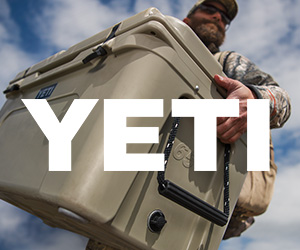|
Culprit
Tassel Lizard
Specifications |
|
Material |
Flavor enhanced soft plastic |
|
Length |
6" |
|
Number per pack |
8 |
| Colors/Patterns |
7 available |
|
Package |
Re-sealable Bag |
| MSRP |
$3.79 |
About Culprit: Classic Fishing Products,
Inc. makes and sells a freshwater line of plastics under the brand name Culprit. Since 1979 they have specialized in producing soft plastic lures in their
privately held company located in South County Lake, Florida. They also
retain other popular brands such as Zeal -
a dropshot lure, Culprit Crappie Baits - for panfish, and RipTide - soft
plastics for saltwater species.

Introducing the multi-tentacle Culprit Tassel Lizard
Impressions: It seems like today's bass fishing
plastics all come with a increasing number of tentacles. The Culprit Tassel Lizard
has multiple limbs for enhanced
attractiveness, but still resembles a traditional
lizard. The Lizards come in 6 or 8 inches and all sizes sport a Tassel tail and
legs used to create a new level of commotion underwater. While the soft plastics are
still in liquid form, a concentrated fish oil formula is added for the ultimate
fish attraction, then molded and finally topped with liquid saline.
Real
World Tests: When fishing before and during the spawn period, lizards are
among one of my favorite lures to toss at points with a good depth change and at the edges of weed patches. The Tassel Lizard came in handy at this
time of the year and we were eager to see exactly how it performed on aggressive largemouth
bass protecting their young.

Most strikes from small aggressive
males happen near the head of the Tassel Lizard, but the tail portion is
critical in luring a bass to commit
Casting: The Tassel Lizard can be tossed with or without the
addition of a weight. While tossing weightless it is best to use lighter
lines which allow the plastic to move and fall naturally. While using 8 lb
test Trilene XL on a spinning rig, it was effortless casting the 6 inch Culprit Lizard. But fishing
this lure weightless results in a much shorter cast and is best reserved for flipping and pitching around structure and cover targeting bass around
their hideouts. The Tassel Lizard was easiest to cast rigged Carolina or
Texas style. With a 1/8 once bullet sinker you are able to cast and position the
lure with precision.

Rigged weedless and weightless,
it's great for flipping and pitching in open weed pockets for hidden largemouth
bass
Retrieve: I'm sure this has been burned into many people's minds
already, lure presentation is probably the most important factor in getting a
fish to strike. You can be chucking a lure all day right in front of the
fish's face, but if you're not doing it right, the fish will just ignore your
efforts.
When using the Culprit Tassel Lizard, one can fish it in many different ways,
but remember, this soft plastic is more buoyant than the traditional plastics.
Thus when used weightless, it falls much slower and can be effective at staying
in the strike zone for extended periods. When fished with a weight, the tail floats
slightly upwards teasing the fish to strike at it. When crawled back on
the bottom, the tail and limbs produce plenty of action thanks to the wavy skirted tail
on the soft plastic. The kicking action of the Tassel tail can also be
effective as you swim it slowly back. When I fished around weed patches,
swimming the Lizard produced as many strikes as it did when dragged on the
bottom.
Another effective method in producing fish using
the Tassel Lizard is a method called Dead-sticking. After you've made your cast,
allow the lure to sit without any action or retrieve. I gave this a try many times and produced fish after fish. Why? Because
the skirted Tassel tail did all the work for me. As the plastic Lizard sat
motionless, underwater currents cause the lure come to live as the tail moves in
tiny natural gestures, getting bass to commit to what they thought was
unsuspecting prey.

This female bass slammed the
plastic as I was dead-sticking over a grass bed that was away from the
shoreline as she moved closer to the spawning grounds
Durability: The
more limbs and tentacles a lure has, the more prone they are to losing
appendages, especially
if they are thin. But how does the Culprit Tassel Lizard hold up against
aggressive male bass fending off predators that come near their nest? I constantly pounded the shoreline grass beds with
the Tassel Lizard to see how many grabs it would last until I noticed something
breaking off. The Tassels took punishment with only decent marks. If
the fish does not engulf the lure and grabs onto a limb, after about 5 fish I
noticed a few tentacles break off, but the Lizard is still affective after that
because there are other Tassels to tease the fish. The majority of the
field tests showed that the bass usually strike at the head or mid-body most
often which brought me to conclude that one Tassel Lizard should hold up to more
then 5 fish in terms of durability.
Ratings:
|
Culprit
Tassel Lizard Ratings (?/10) |
| Construction/Quality |
Overall decent construction for a soft plastic, but the more tentacles it
has, the more likely it'll break off |
8 |
| Performance |
Performs better than the standard lizards I've used before. Effective
when dragging on the bottom or dead-sticking, the Tassel tail is effective
for aggressive bass |
8.5 |
| Price |
These lizards cost more than traditional types but competitive with the new
styles of lizards. If bought in bulk, the price is very good |
8 |
| Features |
Features on the Tassel Lizard is what sets it apart from the others.
Its unique patented Tassel tail and limbs, buoyancy, and impregnated scents all add
up to great actions and performance |
8 |
| Design
(Ergonomics) |
The
design kept the form of a lizard, but enhanced with features that makes it
effective when targeting bass, especially around the spawn period |
8.5 |
| Application |
An
awesome presentation for largemouth bass when they are aggressive. Can
be fished in cold and hot seasons either dragging it on the bottom, pitching
and flipping, or swimming it |
8.5 |
|
Total Score |
8.25 |
Pluses and Minuses:
|
Plus
Minus |
| J
Enticing Tassels |
L
Price might be high, depends on where
you buy them from and in what quantity |
| J
Effective design |
L
Tassels have a higher chance of breaking
off then traditional appendages |
| J
Great during the spawn periods |
|
Conclusion: Today soft plastics aren't as simple as they were
in the past, as they come in all sizes, shapes, and scented with various
types of attractants. Culprit, a company that purely concentrates on
producing soft plastics for fishing, has developed a more attractive and
effective lizard that sports loads of tentacles. The Tassel Lizard still
resembles a lizard in profile, but features skirted appendages for enhanced action when fished
at the bottom, flipped or pitched, or even when swimming. The buoyant body allows
the slow fall, and the tail floats up at an angle flirting
with fish when retrieved at the bottom. When taunting bass around the
spawn period or throughout the year, the Culprit Tassel Tail's unique action
might just be what you need to persuade that lunker to chomp down on your rig.
























